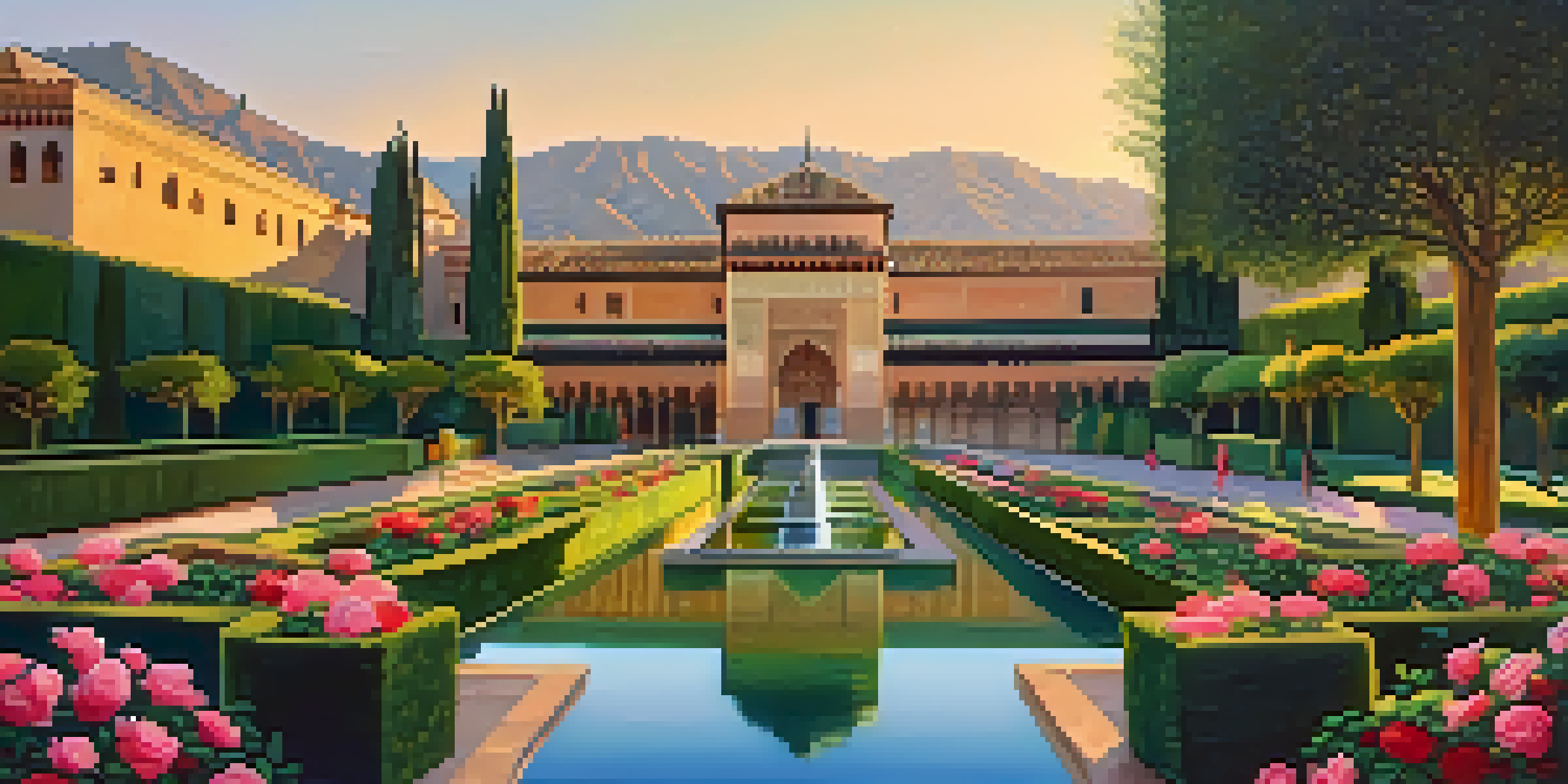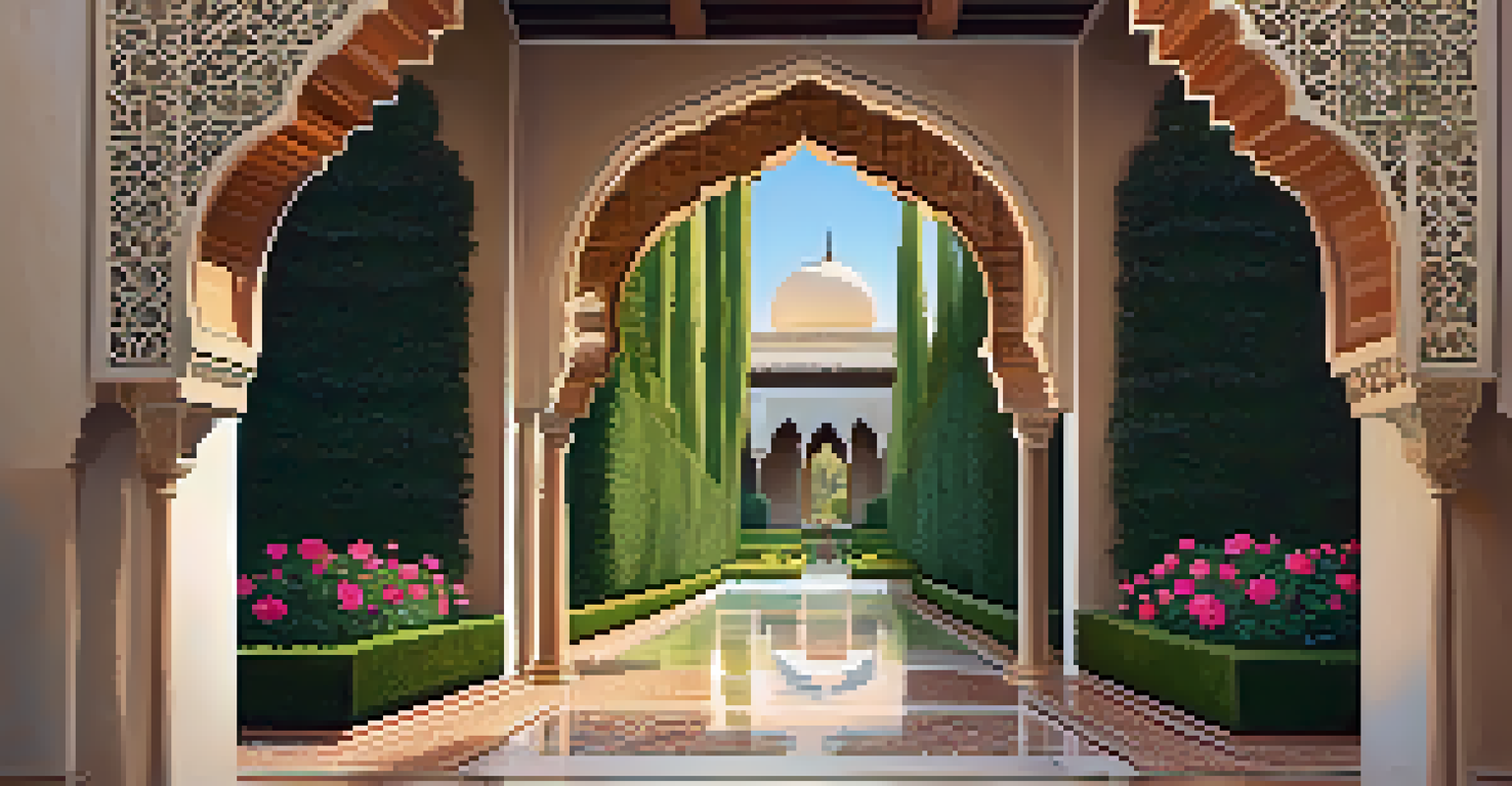The Alhambra: A Glimpse into Spain's Moorish Garden Design

Introduction to the Alhambra and Its Garden Legacy
The Alhambra, a UNESCO World Heritage Site, is a breathtaking example of Moorish architecture and design located in Granada, Spain. Built in the 13th century, this palatial fortress showcases intricate artistry and lush gardens that transport visitors back in time. The gardens of the Alhambra are not merely decorative; they embody the Islamic principles of paradise on earth, making them a significant aspect of the site's allure.
Gardens are not just places to grow plants; they are a reflection of human creativity and a manifestation of our desire for beauty and harmony in the world.
Visitors to the Alhambra often find themselves captivated by the harmony of its gardens, which seamlessly blend nature with architectural elements. The design reflects a deep appreciation for water, plants, and symmetry, creating spaces that are both serene and vibrant. Each garden area tells a story, inviting guests to explore and reflect on the historical significance of the landscape.
Moorish garden design, as exemplified in the Alhambra, emphasizes the relationship between the built environment and the natural world. This approach not only enhances aesthetic beauty but also fosters a sense of tranquility and contemplation, which is essential in Islamic culture. The gardens of the Alhambra are a testament to this philosophy, offering a glimpse into the rich heritage of Moorish Spain.
Key Features of Moorish Garden Design
Moorish garden design is characterized by several key features, including the use of water, symmetry, and diverse plant life. Water plays a central role, not just for irrigation but also as a symbol of life and purity in these gardens. Fountains, pools, and channels create a soothing soundscape and reflect the beauty of the surrounding landscape, enhancing the overall atmosphere.

Symmetry is another hallmark of Moorish gardens, often achieved through geometric designs and carefully arranged plantings. This structural balance creates a sense of order and tranquility, allowing visitors to experience the beauty of nature in a harmonious setting. The layout often includes pathways that guide visitors through the space, encouraging exploration and engagement with the environment.
Alhambra: A Garden of Paradise
The gardens of the Alhambra exemplify Moorish design, embodying the Islamic vision of paradise through their harmonious blend of nature and architecture.
Additionally, the use of a variety of plants—both native and exotic—adds richness and diversity to the gardens. From fragrant jasmine and vibrant roses to towering cypress trees, these plants were chosen for their beauty and symbolism. This variety not only enhances the visual appeal but also reflects the Moorish dedication to integrating nature into their architectural masterpieces.
The Role of Water in Alhambra's Gardens
Water is more than just a decorative element in the Alhambra; it is fundamental to the garden's design and purpose. The intricate water features serve various functions, from cooling the air to creating a peaceful ambiance. Visitors often find themselves drawn to the sound of flowing water, which invites a sense of calm and reflection amidst the bustling beauty of the gardens.
Water is the source of life, and it is essential to the beauty and harmony of the garden, reflecting the interconnectedness of all living things.
In the Alhambra, water is often channeled through narrow streams and pools, creating a network that flows throughout the grounds. This clever engineering not only showcases the advanced knowledge of the Moorish architects but also reflects the cultural significance of water in Islamic tradition. It symbolizes life, renewal, and the divine, making it a vital component of these enchanting gardens.
The incorporation of water features in the Alhambra's gardens also serves a practical purpose, as they help to maintain the moisture levels necessary for the lush plant life. These features are strategically placed to enhance the visual experience, drawing the eye towards the reflections and movements of the water. This interplay of water, light, and greenery creates a captivating environment that leaves a lasting impression on all who visit.
Symbolism of Plants in Moorish Gardens
Plants in Moorish gardens are selected not just for their beauty, but also for their rich symbolism. Each species tells its own story and contributes to the overall message of the garden. For example, the pomegranate symbolizes abundance and prosperity, while the cypress tree represents eternal life, making these choices deeply meaningful in the context of Islamic culture.
The use of fragrant flowers, such as roses and jasmine, also plays a significant role in creating an inviting atmosphere. These plants not only enhance the sensory experience through their scents but also symbolize love and beauty. As visitors wander through these gardens, they are enveloped by the aromas, which evoke feelings of peace and contentment.
Water's Vital Role in Design
Water features in the Alhambra's gardens serve both aesthetic and practical purposes, symbolizing life and enhancing the tranquil ambiance.
Moreover, the arrangement of plants is often intentional, creating specific pathways and viewpoints that guide visitors through a narrative. This thoughtful design provides a multi-sensory experience, encouraging exploration and reflection. In essence, each plant contributes to a larger tapestry of meaning, enhancing the spiritual and aesthetic value of the Alhambra's gardens.
The Influence of Islamic Architecture on Garden Design
The influence of Islamic architecture on garden design is evident in the Alhambra's layout and aesthetic. Islamic principles emphasize the importance of harmony between the built environment and nature, leading to gardens that are designed as extensions of the architecture. This integration fosters a seamless flow between indoor and outdoor spaces, inviting visitors to experience tranquility in both realms.
Architectural elements such as arched doorways, intricate tile work, and ornate stucco plastering are harmoniously incorporated into the garden design. These features not only enhance the visual appeal but also create a cohesive narrative that reflects the values of beauty and order in Islamic culture. The gardens become an integral part of the overall experience, immersing visitors in a world of artistic expression.
Additionally, the use of geometric patterns in both architecture and gardens creates a sense of unity and balance. These patterns, often inspired by nature, mirror the complexities of the universe and hold spiritual significance. The Alhambra serves as a prime example of how Islamic architecture has profoundly influenced garden design, resulting in spaces that are both aesthetically pleasing and spiritually enriching.
Cultural Significance of the Alhambra Gardens
The gardens of the Alhambra hold immense cultural significance, reflecting the rich history and traditions of Moorish Spain. As a symbol of a bygone era, they offer insight into the values, beliefs, and artistic expressions of the time. The gardens serve not only as a historical reminder but also as a space for contemporary reflection and appreciation of cultural heritage.
Throughout history, the Alhambra has inspired countless artists, writers, and architects, each drawn to its beauty and symbolism. The gardens, in particular, have become a source of inspiration for modern landscape designs and continue to influence contemporary gardening practices. Their ability to blend nature with art speaks to a universal desire for beauty and harmony in our surroundings.
Symbolism in Plant Selection
Moorish gardens utilize plants not only for their beauty but also for their rich symbolism, each contributing to a deeper narrative of meaning.
Moreover, the Alhambra's gardens serve as a reminder of the importance of preservation and appreciation of cultural landmarks. As visitors stroll through the lush pathways, they connect with the past and appreciate the artistic achievements of the Moorish civilization. The gardens not only celebrate history but also encourage future generations to value and protect these cultural treasures.
Visiting the Alhambra: An Enchanted Experience
Visiting the Alhambra is akin to stepping into a living museum, where the gardens play a starring role in the overall experience. As you wander through the meticulously designed pathways, the interplay of water, plants, and architecture captivates the senses. Each corner of the garden invites exploration, offering new perspectives and moments of reflection.
For those planning a visit, timing is essential; the gardens are particularly enchanting during the golden hour when the sunlight casts a warm glow over the landscape. This magical ambiance creates perfect opportunities for photography and contemplation. Guided tours can also provide valuable insights, enhancing your understanding of the history and significance of the gardens.

In conclusion, a visit to the Alhambra's gardens is a journey through time and culture, where every element is thoughtfully designed to inspire awe. The lush greenery, soothing waters, and intricate architectural details come together to create an unforgettable experience. Whether you're an architecture enthusiast or a nature lover, the gardens of the Alhambra offer something truly special for everyone.